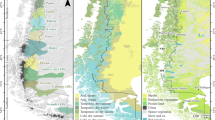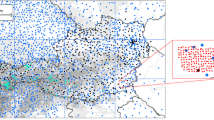Abstract
A high-quality monthly pan evaporation dataset of 60 stations has been developed for monitoring long-term pan evaporation trends over Australia. The quality control process involved examination of historical station metadata together with an objective test comparing candidate series with neighboring stations. Identified points of discontinuity were located, including installations of bird guards, site relocations and changes in exposure. Appropriate inhomogeneity adjustments have been applied using established methods to produce the first homogeneous pan evaporation dataset for Australia. Analysis of these data reveals that Australian annual mean pan-evaporation shows large interannual variability with no trend over the 1970–2005 period. Previous studies using unadjusted data have shown a decline in pan evaporation, highlighting the importance of checking data for homogeneity before drawing conclusions about long-term trends. A strong inverse correlation is evident between all-Australian means of pan evaporation and rainfall, while a moderate positive correlation is found between pan evaporation and mean temperature. The positive correlations between mean temperature and pan evaporation that exist on the interannual time scales are not reflected in the long-term trends, highlighting that the mechanisms that are responsible for variations on the short and longer time scales are different. This result cautions against the expectation that large changes in potential evaporation are a natural consequence of global warming.
Similar content being viewed by others
References
Australian Academy of Science (2005) Pan evaporation: an example of the detection and attribution of trends in climate variables. In Proceedings of a workshop held at the Shine Dome, Australian Academy of Science, Canberra, 22–23 November 2004
Barnes SL (1964) A technique for maximizing detail in numerical weather map analysis. J Appl Meteorol 3:396–409
Bureau of Meteorology (BoM) (2000) Climatic atlas of Australia rainfall. Available from the Australian Bureau of Meteorology, Melbourne, Victoria, Australia. 25 pp
Bureau of Meteorology (BoM) (2001) Surface observation handbook, vol. 2, part 10. Evaporation
CSIRO (2001) Climate change projections for Australia. CSIRO Atmospheric Research, Melbourne Australia. Available from http://www.dar.csiro.au/publications/projections2001.pdf
Della-Marta P, Collins D (2004) Updating Australia’s high-quality annual temperature dataset. Aust Meteorol Mag 53:75–93
Easterling DR, Peterson TC (1995) A new method for detecting undocumented discontinuities in climatological time series. Int J Climatol 15:369–377
Grayson RB, Argent RM, Nathan RJ, McMahon TA, Mein R (1996) Hydrological recipes: estimation techniques in Australian hydrology. Cooperative Research Centre for Catchment Hydrology, Australia, pp 125
Hayhoe HN, Williams GDV (1982) Computing and mapping Thiessen weighting factors from digitized district boundaries and climatological station latitudes and longitudes. J Appl Meteor 21:1563–1566
Hobbins MT, Ramirez JA, Brown TC (2004) Trends in pan evaporation and actual evapotranspiration across the conterminous U.S.: paradoxical or complementary? Geophys Res Lett 31:L13503
Hounam CE (1961) Evaporation in Australia, Bulletin no. 44, Bureau of Meteorology
Jones PA (1991) Historical records of cloud cover and climate for Australia. Aust Meteorol Mag 39:181–189
Jones PA, Henderson-Sellers A (1992) Historical records of cloudiness and sunshine in Australia. J Climate 5:260–267
Jones DA, Trewin BC (2000) On the relationships between the El Nino–Southern Oscillation and Australian land surface temperature. Int J Climatol 20:697–719
Jones D, Collins D, Nicholls N, Phan J, Della-Marta P (2004) A new tool for tracking Australia’s climate variability and change. Bull Aust Meteor Oceanogr Soc 17:65–69
Karoly DJ, Braganza K (2005) A new approach to detection of anthropogenic temperature changes in the Australian region. Meteorol Atmos Phys 89:57–67
Koch SE, DesJardins M, Kocin PJ (1983) An interactive Barnes objective map analysis scheme for use with satellite and conventional data. J Clim Appl Meteorol 22:1487–1503
Lambert FH, Stott PA, Allen MR, Palmer MA (2004) Detection and attribution of changes in 20th century land precipitation. Geophys Res Lett 31(10)
Lawrimore JH, Peterson TC (2000) Pan evaporation trends in dry and humid regions of the United States. J Hydrometeorol 1(6):543–546
Lucas C, Trewin B, Nicholls N (2004) Development of a historical humidity database for Australia. 16th Australia–New Zealand Climate Forum, Lorne, 8–10 November 2004
Nicholls N (2003) Continued anomalous warming in Australia. Geophy Res Lett 30:23–1–23-3
Nicholls N, Drosdowsky W, Lavery B (1997) Australian rainfall variability and change. Weather 52:66–72
Penman HL (1948) Natural evaporation from open water, bare soil and grass. Proc R Soc Lond A 193:120–145
Peterson TC, Golubev VS, Groisman PY (1995) Evaporation losing its strength. Nature 377:687–688
Philipona R, Dürr B (2004) Greenhouse forcing outweighs decreasing solar radiation driving rapid temperature rise over land. Geophys Res Lett 31:L22208
Potter KW (1981) Illustration of a new test for detecting a shift in mean in precipitation series. Mon Weather Rev 109:2040–2045
Raeisaenen J (2002) CO2-induced changes in interannual temperature and precipitation variability in 19 CMIP2 experiments. J Climate 15:2395–2411
Rayner D (2005) Australian synthetic daily class A pan evaporation. Technical Report, Queensland Department of Natural Resources and Mines, pp 38
Rayner DP (2007) Wind run changes: the dominant factor affecting pan evaporation trends in Australia. J Climate 20:3379–3394
Roderick ML, Farquhar GD (2002) The cause of decreased pan evaporation over the past 50 years. Science 298:1410–1411
Roderick ML, Farquhar GD (2004) Changes in Australian pan evaporation from 1970–2002. Int J Climatol 24:1077–1090
Roderick ML, Farquhar GD (2005) Changes in New Zealand pan evaporation since the 1970s. Int J Climatol 25:2031–2039
Roderick ML, Farquhar GD (2006) A physical analysis of changes in Australian pan evaporation. Land & Water Australia Technical Report, Project no. ANU49
Seaman RS (1989) Tuning the Barnes objective analysis parameters by statistical interpolation theory. J Atmos Ocean Technol 6:993–1000
Smith I (2004) An assessment of recent trends in Australian rainfall. Aust Meteorol Mag 53:163–173
Stott PA (2003) Attribution of regional-scale temperature changes to anthropogenic and natural causes. Geophys Res Lett 30:14
Timbal B, Jones DA (2007) Future projections of winter rainfall in South East Australia using a statistical downscaling technique. Clim Change (in press)
Trenberth KE, Fasullo J, Smith L (2005) Trends and variability in column integrated atmospheric water vapor. Clim Dyn 24:741−758
Trewin BC (2001) Extreme temperature events in Australia. PhD thesis, University of Melbourne, Australia
Uppala SM, Kållberg PW, Simmons AJ, Andrae U, da Costa Bechtold V, Fiorino M, Gibson JK, Haseler J, Hernandez A, Kelly GA, Li X, Onogi K, Saarinen S, Sokka N, Allan RP, Andersson E, Arpe K, Balmaseda MA, Beljaars ACM, van de Berg L, Bidlot J, Bormann N, Caires S, Chevallier F, Dethof A, Dragosavac M, Fisher M, Fuentes M, Hagemann S, Hólm E, Hoskins BJ, Isaksen L, Janssen PAEM, Jenne R, McNally AP, Mahfouf J-F, Morcrette J-J, Rayner NA, Saunders RW, Simon P, Sterl A, Trenberth KE, Untch A, Vasiljevic D, Viterbo P, Woollen J (2005) The ERA-40 re-analysis. Quart J R Meteorol Soc 131:2961–3012
Wang XL (2003) Comments on “detection of undocumented changepoints: a revision of the two-phase regression model”. J Climate 16:3383–3385
Wang XL, Feng Y (2004) RHTest user manual. Available from http://www.cccma.seos.uvic.ca/ETCCDMI/RHTest/RHTestUserManual.doc
Watkins AB (2005) The Australia drought of 2005. WMO Bull 54:156–162
Author information
Authors and Affiliations
Corresponding author
Rights and permissions
About this article
Cite this article
Jovanovic, B., Jones, D.A. & Collins, D. A high-quality monthly pan evaporation dataset for Australia. Climatic Change 87, 517–535 (2008). https://doi.org/10.1007/s10584-007-9324-6
Received:
Accepted:
Published:
Issue Date:
DOI: https://doi.org/10.1007/s10584-007-9324-6




